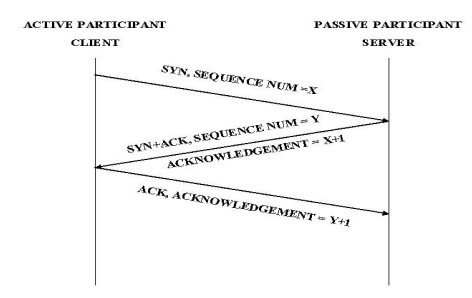Connection Management | Computer Networks - Computer Science Engineering (CSE) PDF Download
Connection Managment
A TCP connection begins with a client doing an active open to a server. Assuming that the server had earlier done a passive open, the two sides engage in an exchange of messages to establish the connection. Only after this connection establishment phase is over do the two sides begin sending data. Likewise, as soon as a participant is done sending data, it closes one direction of the connection, which causes TCP to initiate a round of connection termination messages.
Connection setup is an asymmetric activity (one side does a passive open and the other side does an active open) connection teardown is symmetric (each side has to close the connection independently). Therefore it is possible for one side to have done a close, meaning that it can no longer send data but for the other side to keep the other half of the bidirectional connection opens and to continue sending data.
Three Way Handshakes:
The algorithm used by TCP to establish and terminate a connection is called a three way handshake. The client (the active participant) sends a segment to the server(the passive participation) stating the initial sequence number it plans to use(flag =SYN,SequenceNum =x).
The server then responds with a single segment that both acknowledges the client‟s sequence number (Flags =ACK, Ack=x+1) and states its own beginning sequence number
(Flags=SYN, SequenceNum=y).
That is, both the SYN and ACK bits are set in the Flags field of this second message. Finally, the client responds with a third segment that acknowledges the server‟s sequence number Flags =ACK, Ack=y+1).
The "three-way handshake" is the procedure used to establish a connection. This procedure normally is initiated by one TCP and responded to by another TCP. The procedure also works if two TCP simultaneously initiate the procedure. When simultaneous attempt occurs, each TCP receives a "SYN" segment which carries no acknowledgment after it has sent a "SYN". Of course, the arrival of an old duplicate "SYN" segment can potentially make it appear, to the recipient, that a simultaneous connection initiation is in progress. Proper use of "reset" segments can disambiguate these cases.
The three-way handshake reduces the possibility of false connections. It is the implementation of a trade-off between memory and messages to provide information for this checking.
The simplest three-way handshake is shown in figure below. The figures should be interpreted in the following way. Each line is numbered for reference purposes. Right arrows (-->) indicate departure of a TCP segment from TCP A to TCP B, or arrival of a segment at B from A. Left arrows (<--), indicate the reverse. Ellipsis (...) indicates a segment which is still in the network (delayed). TCP states represent the state AFTER the departure or arrival of the segment (whose contents are shown in the center of each line). Segment contents are shown in abbreviated form, with sequence number, control flags, and ACK field. Other fields such as window, addresses, lengths, and text have been left out in the interest of clarity.

\ 
Basic 3-Way Handshake for Connection Synchronisation
In line 2 of above figure, TCP A begins by sending a SYN segment indicating that it will use sequence numbers starting with sequence number 100. In line 3, TCP B sends a SYN and acknowledges the SYN it received from TCP A. Note that the acknowledgment field indicates TCP B is now expecting to hear sequence 101, acknowledging the SYN which occupied sequence 100.
At line 4, TCP A responds with an empty segment containing an ACK for TCP B's SYN; and in line 5, TCP A sends some data. Note that the sequence number of the segment in line 5 is the same as in line 4 because the ACK does not occupy sequence number space (if it did, we would wind up ACKing ACK's!).
|
21 videos|113 docs|66 tests
|
FAQs on Connection Management - Computer Networks - Computer Science Engineering (CSE)
| 1. What is connection management in networking? |  |
| 2. Why is connection management important in networking? |  |
| 3. What are the common connection management protocols used in networking? |  |
| 4. How does connection management help in preventing congestion in networks? |  |
| 5. What are the challenges in connection management for large-scale networks? |  |

|
Explore Courses for Computer Science Engineering (CSE) exam
|

|


















